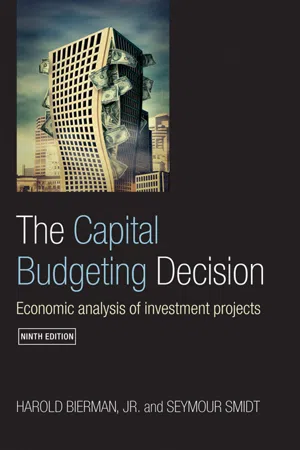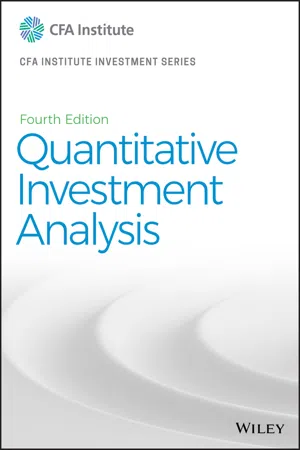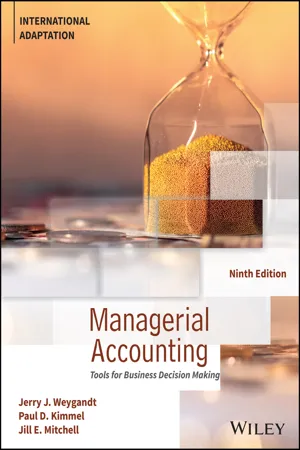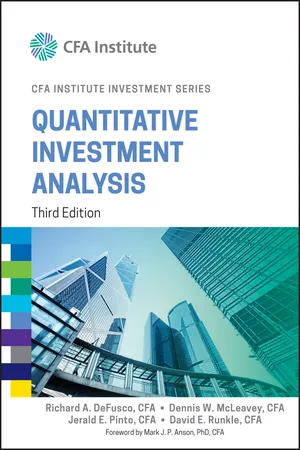Economics
Present Value
Present value is a financial concept that calculates the current worth of a future sum of money, taking into account the time value of money. It is used to determine the value of an investment or a stream of cash flows in today's terms, considering factors such as interest rates and inflation. This calculation helps in making informed financial decisions.
Written by Perlego with AI-assistance
Related key terms
Related key terms
1 of 4
Related key terms
1 of 3
12 Key excerpts on "Present Value"
- Ivan E Brick(Author)
- 2017(Publication Date)
- WSPC(Publisher)
CHAPTER 2TIME VALUE OF MONEY
The Time Value of Money
The value of money a year from now is less than the value of that money today. Why is that? The reason is that you can invest money today and hopefully receive a larger amount in the future. Since money has a time value associated with it, financial analysts must consider the Present Value (PV) of future cash flows when they are making financial decisions.Learning how to take Present Value of future cash flows is one of the most important lessons in finance. Why? As we will discuss later, the price of any asset is the Present Value of its cash flows. Moreover, Present Value provides the framework that allows managers to rank competing capital projects and to help determine the cheapest source of financing.Finding the Present Value of Future Cash Flows
Imagine that our bank is willing to offer us 10% interest on a $100 deposit. At the end of the year the future value (FV) of our investment should be our initial investment of $100 plus the promised interest of 10% on our investment or $110. Another way of saying this is that the promised future value of $110 one year from now has a Present Value of $100 today. In fact, an investor should be indifferent from receiving $100 today or $110 one year from now because the investor is able to invest $100 today at an interest rate of 10% and receive $110 at the end of the year.Let us analyze our problem more closely so that we can generalize the relationship between Present Value and future value. We made the observation that if we invested $100 at 10% it will be worth $110 at the end of year 1. That is, we will receive our original investment of $100 and interest of 10% of that $100. Mathematically this is written as:$100(1.1) = $110. By dividing both sides of that equation by 1.1 we find the Present Value of the $110 or PV = $110/(1.1) = $100. The more general mathematical formula for PV is given by:where CFT is the cash flow at time T and R is the interest rate. In the example above, R is the annual interest of 10%. In our example, T- eBook - ePub
The Capital Budgeting Decision
Economic Analysis of Investment Projects
- Harold Bierman, Jr., Seymour Smidt(Authors)
- 2012(Publication Date)
- Routledge(Publisher)
Chapter 2The Time Value of Money
The frenetic buying of Internet stocks is going to make the tulip buyers of the 17th century look like value players.Rick Berry, director of equity research at J. P. Turner &Company in Atlanta. The New York Times, January 9, 1999Compound interest is one of the wonders of this world. It is the basis of the Present Value calculations. The Safra Bank issued bonds that mature in 1,000 years. The Present Value of $1,000,000,000 of principal payments of this bond at a 0.08 annual interest rate is much less than $0.01. Compound interest is very powerful. A future sum may have a very small Present Value. A very small present amount might grow to a large sum in the future.To better understand the time value of money, we shall first assume that both the discount rate and the dollar amounts are known with certainty. These assumptions enable us to establish basic mathematical relationships and to compute exact relationships between future sums and their Present Values.Time Discounting
One of the basic concepts of business economics and managerial decision-making is that the Present Value of an amount of money is a function of the time of receipt or disbursement of the cash. A dollar received today is more valuable than a dollar to be received in some future time period. The only requirement for this concept to be valid is that there be a positive rate of interest at which funds can be invested or borrowed.The time value of money affects a wide range of business decisions, and how to incorporate time value considerations systematically into a decision is essential to an understanding of finance. The objective of this chapter is to develop skills in finding the present equivalent of a future amount or future amounts and the future equivalent of a present amount.Symbols Used
X Cash flow. If X is greater than zero there is a cash inflow. If X is less than zero, there is a cash outflow. t Time index. It can refer to a point in time or an interval (for example, t - eBook - ePub
Pipeline Rules of Thumb Handbook
A Manual of Quick, Accurate Solutions to Everyday Pipeline Engineering Problems
- M.J. Kaiser, E.W. McAllister(Authors)
- 2022(Publication Date)
- Gulf Professional Publishing(Publisher)
opportunity cost of capital. It represents the opportunity cost (rate of return) foregone by making this particular investment rather than other alternatives of comparable risk.The formula for calculating Present Value is:where PV = Present Value, FV = Future value,r = Discount rate (per compounding period), andn = Number of compounding periods.Example
What is the Present Value of an investment that guarantees to pay you $100,000 three years from now? The first important step is to understand what risks are involved in this investment, and then choose a discount rate equal to the rate of return on investments of comparable risk. Let's say you decide that 9% effective annual rate of interest (9% compounded annually) is an appropriate discount rate.Thus, you would be willing to invest $77,218 today in this investment to receive $100,000 in 3 years.Future value of a single investment
Rearranging the relationship between PV and FV, we have a simple formula to allow us to calculate the future value of an amount of money invested today:where FV = Future value, PV = Present Value, R = Rate of return (per compounding period), and n = Number of compounding periods.Example
What is the future value of a single $10,000 lump sum invested at a rate of return of 10% compounded monthly (10.47 effective annual rate) for 5 years? Note that monthly compounding is used in this example.The $10,000 investment grows to $16,453 in 5 years.The importance of cash flow diagrams
Many financial problems are not nearly as simple as the two previous examples, which involved only one cash outflow and one cash inflow. To help analyze financial problems, it is extremely useful to diagram cash flows, since most problems are considerably more complex than these previous examples and may have multiple, repetitive, or irregular cash flows. The cash flow diagram - Stephan Leimberg, Robert J. Doyle, Michael S. Jackson, Martin J Satinsky(Authors)
- 2019(Publication Date)
- The National Underwriter Company(Publisher)
TIME VALUE OF MONEY AND QUANTITATIVE ANALYSISCHAPTER 19INTRODUCTION1. the effect of time on the profitability of an investment; 2. how the projected value of an investment’s future economic returns affects the price that should be paid for it; 3. how to compute the value of an investment’s future economic return. Sound financial decisions depend on an understanding of the basic mathematics of compound interest. This concept is essential in analyzing the financial consequences of almost any investment.The time value of money is an important concept for sound financial decisions. Present and future value computations provide quantitative techniques for determining the value of time in tax and financial decision-making and are essential in understanding:The concept of investment, by definition, implies a delay in consumption or enjoyment. For an individual to forego current consumption or enjoyment in favor of future consumption there must be some reward. That reward is called profit, which must be large enough to justify, at least in the mind of the investor, the expected delay. The measure of the profit is typically called the rate of return, or the rate of interest.The concept of time value of money also is crucial to the larger picture of any cash flow or goal based financial planning. Planning for the future often involves projecting current and future cash flows and needs, such as for education funding, retirement planning, and estate planning. Effective planning for the future generally involves some estimation of present or future values, so as to put such outflows and inflows on a common footing that can be evaluated. In addition to rates of returns, rates of inflation, growth, tax, and probabilities may be modeled into such planning.- eBook - ePub
- Robert Irons(Author)
- 2019(Publication Date)
- Routledge(Publisher)
Chapter six , “Stock Valuation.”The Fundamental Principles in Action
FP1 equates the value of an asset with the Present Value of the cash flows the asset is expected to produce. This principle is clearly seen when calculating the Present Value of single or multiple cash flows, and is applied (but not so clearly) when calculating the Present Value of annuities. FP3 asserts the inverse relationship between the price of an asset and its yield, or return. This principle is seen when discounting is done more frequently than annually—this effectively increases the discount rate, causing the Present Value of the cash flows to decrease. The interaction between FP1 and FP3 is seen in PR1, which states that increasing the discount rate decreases the Present Value of cash flows.Understanding Why Money Has Time Value—Economic Equivalency
People save their money so that it can earn interest over time. They are free to consume their income now, but choose to postpone consumption and instead invest their money in order to have more money available in the future. Thus, money has time value because investing it will lead to having additional funds available in the future. In this way, a dollar today is worth more than a dollar due one year from today, since it can be invested today to be worth more than a dollar one year from now. In other words, a dollar today and a dollar one year from today are not economically equivalent, since the dollar today has the potential to be worth more than one dollar one year from now.For example, if today you deposit $1,000 into a savings account that pays 5.0% APR (annual percentage rate) compounded annually, at the end of one year you will have $1,000(1.05) = $1,050 in the account. For this situation, given the 5% yield, $1,000 today and $1,050 one year from today are economic equivalents; that is, $1,000 today is economically equivalent to $1,050 one year from today, given the 5% return on the account. If you knew that you had the 5.0% return available on the savings account, then you should be indifferent between receiving $1,000 today or receiving $1,050 one year from today, since they are economically equivalent. - eBook - ePub
- (Author)
- 2020(Publication Date)
- Wiley(Publisher)
Thus the Present Value is the amount available for investment today, indexed as t = 0. We can now refer to a time N periods from today as t = N. The time line in Figure 1 shows this relationship. In Figure 1, we have positioned the initial investment, PV, at t = 0. Using Equation 2, we move the Present Value, PV, forward to t = N by the factor (1 + r) N. This factor is called a future value factor. We denote the future value on the time line as FV and position it at t = N. Suppose the future value is to be received exactly 10 periods from today’s date (N = 10). The Present Value, PV, and the future value, FV, are separated in time through the factor (1 + r) 10. The fact that the Present Value and the future value are separated in time has important consequences: We can add amounts of money only if they are indexed at the same point in time. For a given interest rate, the future value increases with the number of periods. For a given number of periods, the future value increases with the interest rate. FIGURE 1 The Relationship between an Initial Investment, PV, and Its Future Value, FV To better understand these concepts, consider three examples that illustrate how to apply the future value formula. EXAMPLE 1 The Future Value of a Lump Sum with Interim Cash Reinvested at the Same Rate You are the lucky winner of your state’s lottery of $5 million after taxes. You invest your winnings in a five-year certificate of deposit (CD) at a local financial institution. The CD promises to pay 7 percent per year compounded annually. This institution also lets you reinvest the interest at that rate for the duration of the CD - eBook - ePub
- (Author)
- 2002(Publication Date)
- Harvard Business Review Press(Publisher)
9The Time Value of Money
Calculating the Real Value of Your InvestmentKey Topics Covered in This Chapter
- Present and future value
- Net Present Value
- Internal rate of return
- Hurdle rate, discount rate, and the cost of capital
- Economic value added
I N CHAPTER 8, WE EXAMINED return on investment (ROI) and payback period analysis—two tools that managers use to make decisions and assess performance. We noted, however, that these have one important weakness: They fail to account for the time value of money. That is, though they indicate (or estimate) inflows and outflows of cash, ROI and payback analysis fail to recognize when those cash flows take place. As we’ll explain here, the timing of those cash flows matters, and should be factored into management decisions.This chapter will introduce you to financial decision-making tools that account for time value: specifically, present and future value, net Present Value, and internal rate of return. You will also become acquainted with associated concepts that you’re likely to encounter when management discusses serious long-term investments—hurdle rate, discount rate, and the company’s cost of capital. The chapter also includes a discussion of sensitivity analysis, a method that increases the practicality of these time-value tools.What Is Time Value?
The time value of money is a mathematically based recognition that money received today is worth more than an equal amount of money received months or years in the future. If you have any doubts about this statement, consider the following example:Your father-in-law takes you aside and says, “The grim reaper is going to catch up with me one of these days. And as much as I’d like to take all of my money with me, I’ve decided to give you youngsters a bundle of it before I go—say, three hundred thousand dollars.”Naturally, you’re pleased to learn of his generous intention. You are also eager to learn when - Daniel Adrian Doss, William H. Sumrall III, Don W. Jones(Authors)
- 2017(Publication Date)
- Routledge(Publisher)
Some initiatives may require periods that are longer than those that are considered within this text. When these situations occur, it is recommended that NPV calculations be performed through the use of software spreadsheets, proprietary software, or financial calculators. Also, within the context of collegiate finance courses, a tabular solution is also available to solve NPV problems involving a variety of periods. However, for the purposes of this text, the use of the basic formula is appropriate to demonstrate the basic concept of net Present Value and to delineate the calculations through which NPV problems are solved. Future editions of this text, if any, are anticipated to contain the tabular solution methods of NPV problems.6.8 Chapter Comments and Summary
This chapter introduced the net Present Value (NPV) method of capital budgeting. The methods of capital budgeting encompass perspectives of time, cash value, rate, and profitability potential. The NPV is indicative of a cash perspective regarding the rendering of capital budgeting decisions. Further, the NPV method incorporates the time value of money within its primary construct. Derivation of the NPV method can occur through algebraic manipulation of the current monetary value formula given in Chapter 4 .The NPV method involves a consideration of the anticipated cash flows of a capital investment through time. These anticipated future values are discounted to determine their current monetary equivalencies. Conceptually, the NPV is the sum of the present monetary value of the anticipated future cash flows of a potential capital investment excluding the costs of investment. Therefore, the NPV method provides a cash-based perspective regarding capital budgeting initiatives. The NPV may be used as a solitary method of capital budgeting or may be used in conjunction with any (or all) of the capital budgeting methods described within this text. The NPV method may be used to examine single capital initiatives or multiple capital initiatives. Further, this method may be used with or without the constraints imposed by mutual exclusion conditions.- eBook - ePub
Managerial Accounting
Tools for Business Decision Making, International Adaptation
- Jerry J. Weygandt, Paul D. Kimmel, Jill E. Mitchell(Authors)
- 2023(Publication Date)
- Wiley(Publisher)
Table 2 that the future value of an annuity of 1 factor for three payments at 5% is 3.15250.- The future value factor is the total of the three individual future value factors shown in Illustration A.7 . Multiplying this amount by the annual investment of €2,000 produces a future value of €6,305.
The demonstration problem inshows how to use Table 2 .Illustration A.8ILLUSTRATION A.8 Demonstration problem—Using Table 2 for FV of an annuity of 1Present ValueS
LEARNING OBJECTIVE 2
Compute Present Values.Present Value Variables
The Present Value is the value now of a given amount to be paid or received in the future, assuming compound interest.- The Present Value, like the future value, is based on three variables:
- The euro amount to be received (future amount).
- The length of time until the amount is received (number of periods).
- The interest rate (the discount rate).
- The process of determining the Present Value is referred to as discounting the future amount .
Present Value computations are used in measuring many items. For example, the Present Value of principal and interest payments is used to determine the market price of a bond. Determining the amount to be reported for notes payable and lease liabilities also involves Present Value computations. In addition, capital budgeting and other investment proposals are evaluated using Present Value computations. Finally, all rate of return and internal rate of return computations involve Present Value techniques.Present Value of a Single Amount
To illustrate Present Value, assume that you want to invest a sum of money today that will provide €1,000 at the end of one year. What amount would you need to invest today to have €1,000 one year from now? If you want a 10% rate of return, the investment or Present Value is €909.09 (€1,000 ÷ 1.10). The formula for calculating Present Value is shown in.Illustration A.9ILLUSTRATION A.9 Formula for Present ValuePresent Value ( - eBook - ePub
- Scott Kays(Author)
- 2011(Publication Date)
- Wiley(Publisher)
5. Enter the number of periods 5, N 6. Compute the future value CPT, FV Voilà! The calculator produces the value of 1.61. THE Present Value OF A FUTURE INCOME STREAMTo paraphrase Yogi Berra, the Present Value is a similar concept—only different. Instead of calculating the future value of a current sum, you start with a future lump sum and compute its worth today, known as discounting the future sum. The interest rate used is called the discount rate.Key Point Understanding how to discount future sums of money to Present Values is essential to valuing stocks.To illustrate the Present Value concept, let’s revisit Table 10.1 . Assuming a 7 percent discount rate, you can see that a dividend of $1.07 in one year equates to a $1 dividend today. Just as $1.07 is the future value of today’s $1, $1 is the Present Value of next year’s $1.07. Similarly, at a 10 percent discount rate, $1 is the Present Value of $1.61 received five years from now. Using different discount rates and time periods, you can develop a Present Value table, such as the one found in Table 10.2 .To find today’s equivalent of $100 received 10 years from now, assuming a 10 percent discount rate, find the number in Table 10.2 that intersects the 10% column and 10 years row, which is 0.386. Multiply 0.386 by $100 to arrive at the Present Value of $38.60.TABLE 10.2 Present Value of $1A Present Value table has the same limitations as a future value table. Therefore, you should become familiar with the following formula for calculating Present Values: where:Computing the Present Value of $150 to be received three years from now using a 7 percent discount rate: Present Values can also be calculated quickly using your trusty Texas Instruments BA II Plus by following these steps:PV = Present ValueFV = future valuei = discount raten = number of future time periods being discountedStep Keystrokes 1. Set periods per year equal to one 2nd, P/Y, 1, Set 2. Change calculator mode 2nd, Quit 3. Enter the number of periods - eBook - ePub
- Brümmer LM, Hall JH, Du Toit E(Authors)
- 2017(Publication Date)
- Van Schaik Publishers(Publisher)
1439The time value of money
Learning outcomes
After studying this chapter, you should- fully grasp the meaning of the time value of money
- understand the concepts of future and Present Values
- know how to calculate future and Present Values
- understand the concepts of the future and Present Value of annuities
- know how to calculate the future and Present Value of annuities
- understand the concept of amortisation.
Introduction
Although at first glance the time value of money may not appear to be related to the reading and analysis of financial statements, it has a direct bearing on the financial statements. To explain this remark, let us find an example that would require application of the principle of the time value of money.Let us consider the investment of working capital in accounts receivable, one of the current assets in the Statement of Financial Position. When an organisation allows its debtors to buy on credit, the organisation is, in effect, making an investment in accounts receivable because the organisation’s money will be tied up or invested in accounts receivable until the debtors pay their accounts. The investment ends when debtors settle their accounts, and accounts receivable finally become cash.The concept of the time value of money
When debtors settle their accounts late, the time value of the money invested in accounts receivable becomes important. The concept of the time value of money simply means that it is more profitable, and therefore preferable, to receive money now rather than at some time in the future. 144There are two reasons for this preference. The first concerns risk. The longer a creditor has to wait for his money, the greater is the chance or risk that some problem will arise to cause financial loss. An example of such a problem would be the debtor being declared insolvent before paying his debt.The second reason concerns the opportunity cost of capital. Most investors prefer to invest their funds as soon as possible in order to receive a return as quickly as possible from the most profitable investment opportunities available. When investors have to wait too long, they stand to lose opportunities in the present - eBook - ePub
- Richard A. DeFusco, Dennis W. McLeavey, Jerald E. Pinto, David E. Runkle, Mark J. P. Anson(Authors)
- 2015(Publication Date)
- Wiley(Publisher)
The additivity and equivalence principles also appear in another common situation. Suppose cash flows are $4 at the end of the first year and $24 (actually separate payments of $4 and $20) at the end of the second year. Rather than finding Present Values of the first year’s $4 and the second year’s $24, we can treat this situation as a $4 annuity for two years and a second-year $20 lump sum. If the discount rate were 6 percent, the $4 annuity would have a Present Value of $7.33 and the $20 lump sum a Present Value of $17.80, for a total of $25.13.Figure 9 The Additivity of Two Series of Cash Flows8. Summary
In this reading, we have explored a foundation topic in investment mathematics, the time value of money. We have developed and reviewed the following concepts for use in financial applications:- The interest rate, r, is the required rate of return; r is also called the discount rate or opportunity cost.
- An interest rate can be viewed as the sum of the real risk-free interest rate and a set of premiums that compensate lenders for risk: an inflation premium, a default risk premium, a liquidity premium, and a maturity premium.
- The future value, FV, is the Present Value, PV, times the future value factor, (1 + r)N.
- The interest rate, r, makes current and future currency amounts equivalent based on their time value.
- The stated annual interest rate is a quoted interest rate that does not account for compounding within the year.
- The periodic rate is the quoted interest rate per period; it equals the stated annual interest rate divided by the number of compounding periods per year.
- The effective annual rate is the amount by which a unit of currency will grow in a year with interest on interest included.
- An annuity is a finite set of level sequential cash flows.
- There are two types of annuities, the annuity due and the ordinary annuity. The annuity due has a first cash flow that occurs immediately; the ordinary annuity has a first cash flow that occurs one period from the present (indexed at t = 1).
- On a time line, we can index the present as 0 and then display equally spaced hash marks to represent a number of periods into the future. This representation allows us to index how many periods away each cash flow will be paid.
Index pages curate the most relevant extracts from our library of academic textbooks. They’ve been created using an in-house natural language model (NLM), each adding context and meaning to key research topics.
Explore more topic indexes
Explore more topic indexes
1 of 6
Explore more topic indexes
1 of 4











